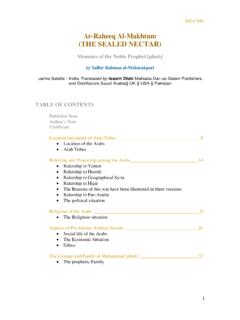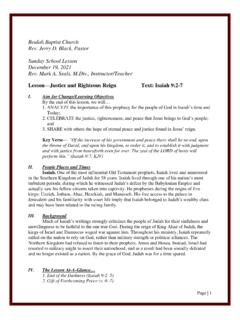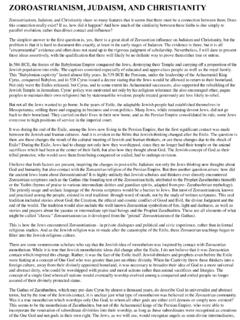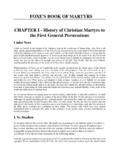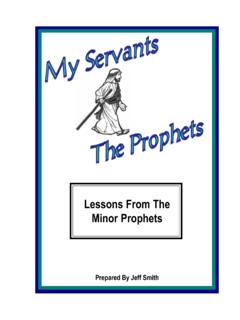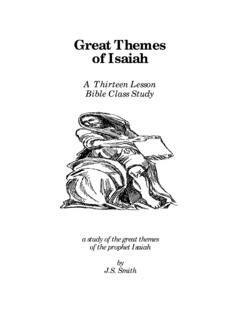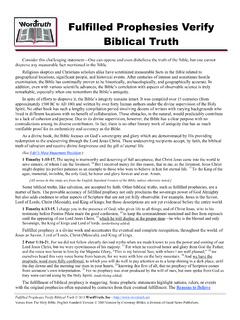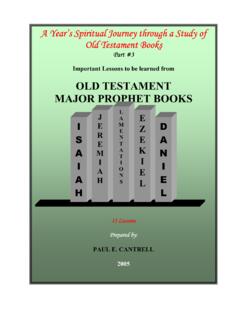Transcription of The Dead Sea Scrolls
1 The Dead Sea Scrolls The Dead Sea Scrolls By Misheal Al-Kadhi, from the Arabic Paper The Scrolls and scroll fragments recovered in the Qumran environs represent a voluminous body of Jewish documents, a veritable "library", dating from the third century to 68 Unquestionably, the "library," which is the greatest manuscript find of the twentieth century, demonstrates the rich literary activity of Second Temple Period Jewry and sheds insight into centuries pivotal to both Judaism and Christianity. The library contains some books or works in a large number of copies, yet others are represented only fragmentarily by mere scraps of parchment. There are tens of thousands of scroll fragments.
2 The number of different compositions represented is almost one thousand, and they are written in three different languages: Hebrew, Aramaic, and Greek. The main categories represented among the Dead Sea Scrolls : Biblical Those works contained in the Hebrew Bible. All of the books of the Bible are represented in the Dead Sea Scroll collection except Esther. Apocryphal or pseudepigraphical Those works which are omitted from various canons of the Bible and included in others. Sectarian Those Scrolls related to a pietistic commune and include ordinances, biblical commentaries, apocalyptic visions, and liturgical works. The Discovery In 1947, young Bedouin shepherds, searching for a stray goat in the Judean Desert, entered a long-untouched cave, on the shores of the dead sea, and found jars filled with ancient Scrolls .
3 That initial discovery by the Bedouins yielded seven Scrolls and began a search that lasted nearly a decade and eventually produced thousands of scroll fragments from eleven caves. These Scrolls were immediately identified as the work of a very devout sect of the Jewish community that lived centuries before the birth of Jesus (pbuh). Hershel Shanks says in his book Understanding the Dead Sea Scrolls : "Such was the discovery of the Dead Sea Scrolls , manuscripts a thousand years older than the oldest known Hebrew texts of the Bible, manuscripts many of which were written a hundred years before the birth of Jesus and at least one of which may have been written almost three hundred years before the journey of Mary and Joseph to Bethleham" (Understanding the Dead Sea Scrolls , Hershel Shanks, pp.)
4 7-8). An immediate frantic search ensued through the remaining caves in the region in order to find what other ancient Scrolls could be discovered therein. A small group of "international" scholars in Israel were given exclusive access to them and the rest of the world was all but totally barred from gaining even the slightest glimpse of the texts. Prof. Eisenman observes that one of the major stumbling blocks for the publication of the Scrolls was that "in the first place, the team was hardly "international". Prof. Robert Eisenman was one of the key players in the drama that finally lead to the release of the Scrolls . In his book The Dead Sea Scrolls Uncovered we read: "In the spring of 1986, at the end of his stay in Jerusalem, Professor Eisenman went with the British scholar, Philip Davies of the University of Sheffield, to see one of the Israeli officials responsible for this - an intermediary on behalf of the Antiquities Department (now 'Authority') and the International Team and the Scrolls Curator at Israel Museum.
5 They were told in no uncertain terms 'You will not see the Scrolls in your lifetimes'". This stung them into action, and as a result of this statement, a massive effort was launched and five years later, through a whirlwind of media publicity, absolute access to the Scrolls was attained. Prof. Eisenman eventually received 1800 pictures of the previously unpublished Scrolls . The book goes on to describe how "Eisenman was preparing the Facsimile Edition of all unpublished plates. This was scheduled to appear the following spring through E. J. Brill in Leiden, Holland. Ten days, however, before it's scheduled publication in April 1991, after pressure was applied by the International Team, the publisher inexplicably withdrew and Hershel Shanks (author of Biblical Archiology Review) and the Biblical Archeology Society to their credit stepped in to fill the breach".
6 However, finally in September 1991, the archives were officially opened and two months later the 2-volume Facsimile Edition was published. We have already read the words of Mr. Tom Harpur in the preface to his book: "The most significant development since 1986 in this regard has been the discovery of the title "Son of God" in one of the Qumran papyri (Dead Sea Scrolls ) used in relation to a person other than simply reinforces the argument made there that to be called the Son of God in a Jewish setting in the first century is not by any means the same as being identical with God Himself." For Christ's Sake, pp. xii. So why don't we study these Scrolls in a little more detail and see what else we can learn?
7 The Dead Sea Scrolls consist of fragments from many manuscripts. However, some of the most interesting among them are the Pesher texts. The Pesher texts are strings of interpretations of Biblical verses compiled by the most knowledgeable among the Jews. The word itself is derived from the Hebrew root word p-sh-r, which means, "to explain". The texts consist of Biblical passages followed by the words pesher ha-davar "the interpretation of the matter is", and then the interpretation itself. The basis of all of these texts is the notion that all of history is preordained by God. In other words, God is not restricted to looking at matters as "past", "present", or "future", rather, all of time is an open book to God.
8 Indeed, this is the essence of how prophets receive "prophesies", because God "sees" the future. So, remembering that we are henceforth quoting from texts that have been carbon dated at about 100 years or more before the coming of Jesus (pbuh), and that this dating is confirmed by literary analysis, and that the authors were a sect of very religious and devout Jews, considering all of this let us see what they have to say: Those who have studied the Scrolls have noticed a common theme prevalent throughout these manuscripts, that is, most of the pesher texts prophesies the coming of a "Teacher of Righteousness" who will be sent by God to the Jews. This "Teacher of Righteousness" will be opposed by the "Teacher of Lies" and the "Wicked Priest".
9 These Scrolls also predict the coming of two messiahs. These two messiahs are referred to as a 1) priestly and a 2) temporal messiah What we had here was a society of very devout Jews who were convinced that the time of the coming of the two messiahs was at hand, therefore, they set about preparing for their advent by detaching themselves from the mainstream society, and dedicating their lives to their worship and the preparation for their imminent arrival. In The Dead Sea Scrolls Uncovered, by Robert Eisenman and Michael Wise, we read that the early Scrolls spoke of two messiahs, but that later on, the communities of the Jews began to combine them into one messiah : "As we have suggested, contrary to the well-known 'two- messiah ' theory of early Qumran scholarship, these references to the ' messiah of Aaron and Israel' in the Damascus Document are singular not and one possible explanation for it is that it is evoking a messiah with both priestly and kingly implications, like the somewhat similar recitations of Hebrews" (The Dead Sea Scrolls Uncovered, Robert Eisenman and Michael Wise, p.
10 162). "According to the dominant view in the sectarian texts from Qumran, two messiahs were to lead the congregation in the End of Days, one priestly, and the other lay" (Reclaiming the Dead Sea Scrolls , Lawrence H. Schiffman, pp. 321-322). The Jews had prophesies of two messiahs. The first was best known to them for his "religious" or "priestly" works which he would perform. The second was best known to them for his "kingly" works; his bringing of an epoch of peace. These two prophesies refer to Jesus (pbuh) and Muhammad (pbuh). Jesus (pbuh) was best know for his "priestly" works. However, he never lead an army, and he never established a kingdom or a government. Quite the opposite, he called to peace and submissiveness and to leave the rule of the land to others (Matthew 22:21).




